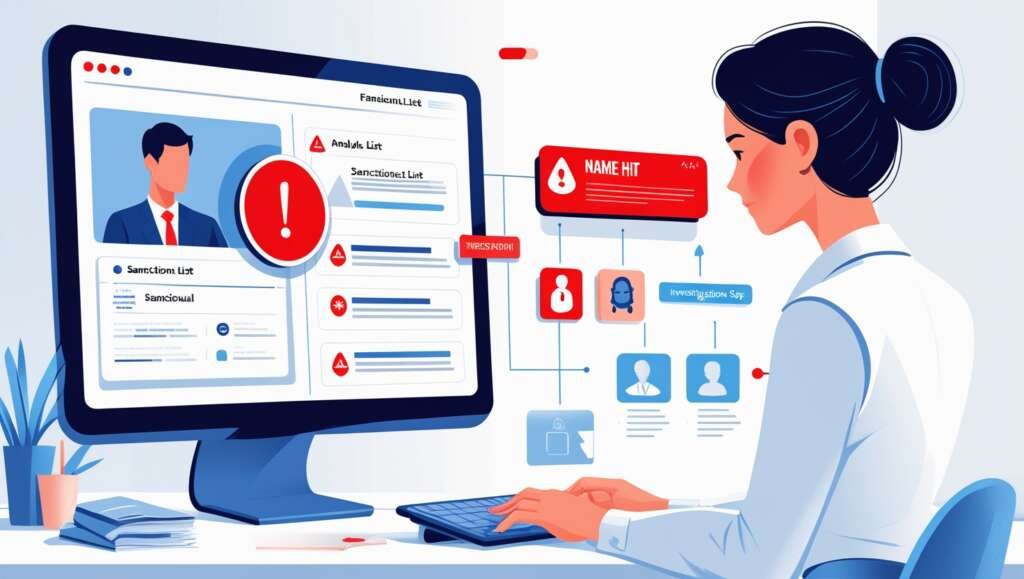Imagine this: You’re a compliance analyst, coffee in hand, scrolling through routine customer onboarding applications. Suddenly, your screening software flags a “hit.” The screen flashes, an alert pops up, and your heart might just skip a beat. Is it a match? Is this person on a sanctions list? Do we need to freeze assets immediately?
For most people, the phrase “sanctions hit” triggers instant panic, conjuring images of international crime and immediate financial shutdown. But in the intricate world of Know Your Customer (KYC) and Anti-Money Laundering (AML) compliance, not every “hit” means a “match,” and not every “match” leads to an immediate rejection. Understanding this nuanced flow is absolutely critical for every compliance professional, especially if you’re involved in onboarding, periodic reviews, or remediation.
So, what exactly happens when a name pings on that digital radar? Let’s take a deep breath, and break it down.
What Exactly is a “Name Hit”?
First things first, let’s define our terms. A “name hit” occurs when a customer’s personal or entity name – whether it’s an individual, a company, a vessel, or even an aircraft – partially or fully aligns with an entry on a sanctions list. These lists, like those maintained by the US Office of Foreign Assets Control (OFAC), the United Nations (UN), or the European Union (EU), contain names of individuals and entities deemed threats to national security or foreign policy.
The “hit” is usually generated by automated screening tools. These aren’t just simple search engines; they employ sophisticated fuzzy logic, phonetic matching (thinking about names that sound alike but are spelled differently), and aliases to catch even slight resemblances. The goal is to cast a wide net, ensuring nothing slips through.
But here’s the crucial reality check:
- Not every hit is a true match. Most are simply similar-sounding names or common spellings.
- Not every true match leads to immediate rejection. The action depends heavily on the type of list and the nature of the listing.
- Many are false positives. These are the vast majority of hits, harmless alerts that need to be efficiently cleared.
So, when that alert flashes, it’s not a red flag yet; it’s a prompt for deeper scrutiny. Think of it as the system tapping you on the shoulder, saying, “Time for a closer look!”
What Happens After a Hit?
The journey from a “name hit” to a final decision is a systematic, multi-layered process designed to be both thorough and efficient. Let’s walk through the six key steps:
Step 1: The Hit is Triggered in the Screening Tool
Every firm’s sanctions screening software, constantly is updated with the latest sanctions lists, scans new customer applications or existing customer profiles during periodic reviews. The name (individual or entity) you’re screening triggers a potential match against an entry on one or more sanctions databases.
This trigger is often due to the tool’s advanced algorithms, which are designed to catch variations. Think about how many ways “Mohammed” can be spelled, or how common “Li” is in certain regions. The software uses these fuzzy logic capabilities to flag anything that could be a match, even if it’s not exact. It’s an automated alert, not a definitive verdict, and it’s the very first step in a larger investigative process.
Step 2: Initial Review (Level 1 Analysis)
Once the hit is triggered, the case lands on the desk of a Level 1 Analyst. This is the first line of defense, a crucial role focused on quickly assessing basic fields to clear obvious false positives.
A Level 1 Analyst will swiftly compare fundamental data points from the customer’s profile against the sanctions list entry. This usually includes:
- Full Name: Is the spelling completely different? Does it have extra names or missing parts?
- Date of Birth: A clear mismatch here (different year, month, or day) can often be an immediate dismissal.
- Country of Residence/Nationality: If your customer is from Argentina and the sanctioned individual is clearly listed as being from North Korea, that’s a strong indicator of a false positive.
- Identification Numbers: If available (like passport numbers or national ID numbers), these are powerful differentiators.
If these basic fields clearly don’t align, the Level 1 Analyst can usually clear the case as a false positive right away. This is about efficiency – preventing unnecessary escalations. However, if there’s any partial alignment – perhaps the same name and a similar country, or just a very common name with no other immediate distinguishing factors – the case is then escalated for a deeper dive.
Step 3: The Deeper Dive (Level 2 Investigation)
This is where the real detective work begins. Escalated cases land with Level 2 Investigators or more senior compliance analysts, who bring a more thorough and investigative approach. Their goal is to gather enough corroborating evidence to definitively determine if it’s a true match or a more complex false positive.
These seasoned investigators go beyond basic data. They will:
- Compare Official Documents: They access all available internal KYC documents – passports, national IDs, utility bills, company registration documents – to cross-reference every detail with the sanctions list entry. They look for middle names, aliases, and specific addresses.
- Utilize Open-Source Intelligence (OSINT) Tools: This involves judicious use of publicly available information. While a simple Google search might be a starting point, professional investigators use advanced, reliable open-source tools. This includes news archives, social media analysis (with caution and adherence to privacy guidelines), corporate registries, and public court records. The goal is to build a comprehensive picture.
- Leverage Commercial Databases: They will access specialized commercial databases like LexisNexis, World-Check (Refinitiv), Dow Jones Risk & Compliance, and others. These platforms aggregate vast amounts of sanctions data, adverse media, PEPs, and watch lists, often providing additional identifying information, aliases, dates of birth, places of birth, and associated entities that are crucial for a definitive match.
- Apply Match Criteria: Investigators apply match criteria based on the firm’s internal policies and regulatory guidance. For instance, OFAC often employs a “50% rule” for entities – meaning if a sanctioned individual owns 50% or more of an entity, that entity is also considered sanctioned, even if it’s not explicitly named. Match criteria also involve assessing the weight of multiple partial matches (e.g., same name + similar country + similar date of birth range is a higher indicator than just a name).
The diligence applied here is paramount. Investigators must gather sufficient evidence to support their final recommendation.
Step 4: Decision: True Match vs. False Positive
After the exhaustive Level 2 investigation, a definitive decision is made, often requiring sign-off from a Compliance Officer or a designated decision-maker.
- False Positive: If the investigation conclusively determines that the customer is NOT the sanctioned individual/entity (e.g., dates of birth are completely different, specific aliases don’t match, or corroborating evidence points elsewhere), the case is cleared as a false positive. This outcome is meticulously logged in the screening system, detailing the reasons for clearance and the evidence reviewed. This logging is crucial for audit trails and to prevent the same false hit from triggering endless investigations.
- True Match: If the investigation confirms, with a high degree of certainty, that the customer is the individual or entity on a sanctions list, it’s declared a true match. This is the moment when the yellow flag turns definitively red. The gravity of this decision cannot be overstated, as it triggers immediate and significant actions with severe legal consequences if mishandled.
Step 5: Action Based on Type of Match
A true match is never just a data point; it’s a call to immediate, legally mandated action. The specific response depends on the type of list the match is found on:
- Sanctions Lists (e.g., OFAC, UN, EU, HMT): These are the most critical. A confirmed match against a sanctions list triggers immediate and legally binding actions, typically without discretion. This could involve:
- Immediate Rejection: If the customer is applying for a new service, their application must be rejected immediately, and no business relationship can be established.
- Freezing Assets: For existing customers, any assets they hold with the institution must be immediately frozen (blocked). This means no further transactions can be processed, and the funds/assets cannot be moved, transferred, or accessed by the sanctioned party. This is a strict legal requirement.
- Reporting to Authorities: The institution is legally obligated to report the true match and the frozen assets to the relevant sanctions authority (e.g., OFAC in the US, the Financial Intelligence Unit in the UAE). Non-compliance can lead to massive fines and criminal penalties.
- Politically Exposed Persons (PEP) Lists: A match against a PEP list doesn’t mean the individual is sanctioned or illicit. PEPs are individuals in prominent public functions (e.g., heads of state, politicians, senior government officials, judges) who, by their position, are considered to pose a higher risk for potential involvement in bribery or corruption.
- Enhanced Due Diligence (EDD): For PEPs, the action is to initiate Enhanced Due Diligence (EDD). This involves a much deeper dive into their background, including verifying their Source of Funds (how they earned their money) and Source of Wealth (where their accumulated wealth comes from), understanding their family members and close associates, and assessing the nature of their business activities. The goal is to understand the heightened risk and monitor the relationship more closely, not necessarily to reject them.
- Adverse Media / Watch Lists: A match against an adverse media database or a general watch list means the individual has been associated with negative news (e.g., allegations of fraud, money laundering, corruption, criminal activity).
- Investigation and Risk Assessment: The action is to investigate the nature and credibility of the adverse media. This requires understanding the severity of the allegations, whether they led to convictions, and their relevance to financial crime. Based on this assessment, the customer’s risk profile may be elevated, leading to EDD or, in severe cases, a decision to exit the relationship. It does not automatically lead to rejection or freezing.
Step 6: Regulatory Reporting (if required)
For a true match against a sanctions list, or for certain high-risk PEP/adverse media cases where suspicious activity is detected, regulatory reporting becomes a critical and legally mandated step.
- Suspicious Activity Reports (SAR) / Suspicious Transaction Reports (STR): If a true hit reveals suspicious activity or a confirmed sanctions nexus, a SAR (or STR in some jurisdictions, like the UAE) must be filed. These reports are submitted to the relevant Financial Intelligence Unit (FIU) – in the UAE, this is done via the GoAML platform.
- Purpose: The purpose of an SAR/STR is to alert law enforcement to potential illicit financial activity. The decision to file rests with the firm’s Money Laundering Reporting Officer (MLRO) or designated Compliance Officer.
- Confidentiality: It’s paramount that the filing of an SAR/STR, and indeed the entire sanctions investigation process, is conducted with the utmost confidentiality. Tipping off a customer that they are being investigated or that a report has been filed is a serious offense with severe penalties.
Common Mistakes to Avoid
While the process seems straightforward on paper, human error and oversight can introduce significant risks. Here are common mistakes to steer clear of:
- Clearing Matches Without Full Document Check: This is a cardinal sin. Rushing to clear a hit without exhaustively comparing all official documents (passport, ID, proof of address, company incorporation papers) against every detail in the sanctions entry can lead to missing a true match and incurring severe regulatory penalties.
- Ignoring Middle Names or Aliases: Sanctioned individuals frequently use variations of their names, including middle names, multiple aliases, former names, or even common nicknames. A superficial check that only matches first and last names is insufficient.
- Relying Solely on Tool Scores Instead of Manual Logic: Screening software often provides a “score” indicating the likelihood of a match. While helpful, these scores are merely indicators. Human judgment, contextual analysis, and corroborating evidence must be the final arbiters. Over-reliance on automation can lead to complacency and missed hits.
- Forgetting to Update Disposition Logs: Every hit, whether a false positive or a true match, must have its disposition meticulously logged within the screening system. This creates a crucial audit trail, demonstrates due diligence to regulators, and helps avoid re-investigating the same false positive repeatedly.
- Inadequate Ongoing Monitoring: Sanctions lists are dynamic, changing frequently. A customer cleared today could be added tomorrow. Failing to implement robust ongoing screening (e.g., daily or weekly automated checks of the entire customer base) is a significant vulnerability.
- Not Understanding Different List Types: Treating a PEP hit the same as an OFAC SDN (Specially Designated Nationals) hit is a critical error. The actions required are vastly different, and misunderstanding these distinctions can lead to either unnecessary rejections or dangerous non-compliance.
- Lack of Clear Internal Policies and Training: Without well-defined internal policies outlining every step of the sanctions screening process, and without regular, comprehensive training for all staff involved, inconsistencies and errors are inevitable.
- Tipping Off: Directly or indirectly informing a customer that they are being screened or reported to authorities is a serious criminal offense. All investigations must be conducted discreetly.
Staying Vigilant in a Complex World
The world of sanctions screening is complex, ever-evolving, and critical to global financial security. It’s a field where attention to detail, robust processes, and a deep understanding of both technology and regulatory mandates are paramount.
For financial institutions and compliance professionals, managing sanctions screening isn’t just about avoiding fines; it’s about safeguarding national security, preventing financial crime, and maintaining the integrity of the global financial system. So, the next time that “name hit” alert pops up, remember: it’s not a panic button, but rather the first step in a crucial, methodical investigation designed to keep us all safer.




